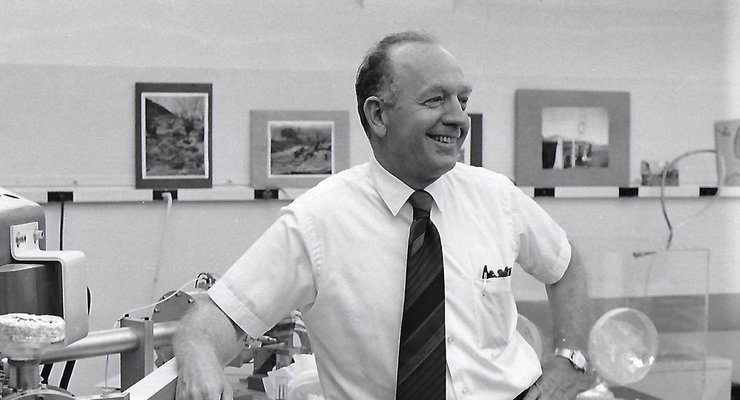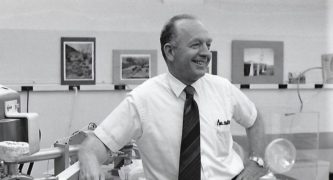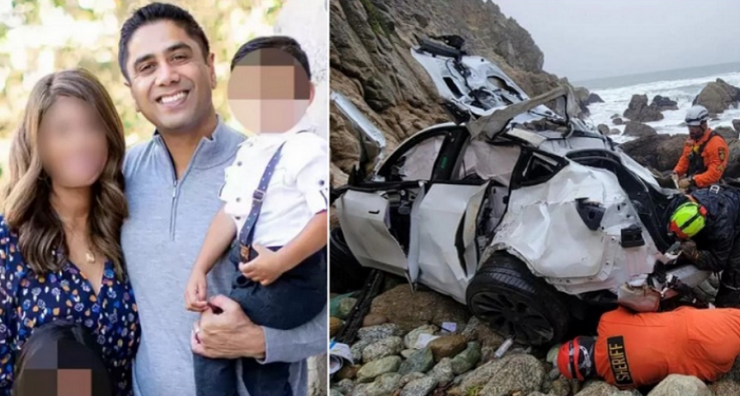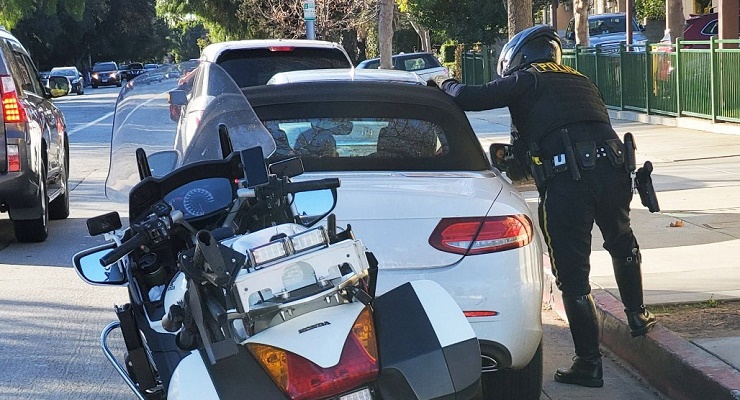
Leon Silver (PhD ’55), W. M. Keck Foundation Professor for Resource Geology, Emeritus, at Caltech, passed away on January 31, 2022. He was 96 years old.
Silver was born in Monticello, New York, on April 9, 1925, the youngest of seven children, two of whom did not survive to adulthood. His father and mother emigrated from Russia and Poland, respectively, and moved to New York, where Silver was born. Soon after his birth, Silver’s family relocated to Connecticut, where he went to school.
Silver graduated from high school in 1942, just months after the United States entered World War II. He was offered scholarships for both political science/history and geology, and ultimately chose to study geology—following in the footsteps of his older brother, Caswell, who had become a geologist. He initially went to the Colorado School of Mines and joined the Navy Reserve, but he was called up to active service in 1943, having turned 18 three months earlier.
Through the V-12 Navy College Training Program, which paid the college tuition of engineering students who were expected to become naval officers at the end of their studies, Silver earned a bachelor’s degree from University of Colorado in 1945. During his time in the service, he received a Naval Civil Engineer Corps commission and was assigned to help build the Hunters Point Naval Shipyard in San Francisco (which was closed in 1994). Silver served in the navy until 1946, then earned a master’s degree from the University of New Mexico in 1948. While in New Mexico, Silver applied for and received a summertime appointment as a junior field assistant to the United States Geological Survey (USGS). Over the course of eight summers working for the USGS, Silver tackled a wide range of projects—from studying volcanic rocks in the San Juan Mountains of Colorado to searching for uranium for nuclear energy projects.
The USGS offered Silver a full-time position, but his supervisor at the time—Caltech alumnus Vincent C. Kelley (MS ’32, PhD ’37)—suggested he pursue a doctoral degree first and recommended Caltech. And so, in 1948, Silver began a doctorate at the Institute.
At the time, Caltech’s nascent geology division (founded in 1926) was small, with fewer than a dozen faculty members. Silver spent seven years in residency as a graduate student during a time of major transition for the division.
An early focus of the division had been paleontology: paleontologist Chester Stock served as division chair from 1947–50, and also as chief science curator at the Los Angeles County Museum of History, Science, and Art (now the Natural History Museum of Los Angeles County) for several years. After Stock died in December 1950, his successor as division chair, Robert Sharp (BS ’34, MS ’35, and namesake of Mars’s Mount Sharp, the base of which served as the landing site for the Mars Curiosity rover in 2012), negotiated the sale of the division’s paleontological specimens to the Natural History Museum and used the proceeds to purchase mass spectrometers and fund other facilities for studying geochemistry.
Silver found himself recruited for numerous geochemistry-related projects throughout the division, which included a lot of time spent in the field. In one notable instance, he wound up ranging all over a portion of Canada in search of the geologic source of a rock sample that geochemist Harrison Brown was working with. (Brown, an alum of the Manhattan Project, later became an outspoken critic of nuclear weapons and after the war applied his efforts to the study of meteorites, jet propulsion, and geochemistry and planetary structure, among other things.) The sample been donated by a researcher who had since died, and Silver used the deceased scientist’s notes as a guide.
“Well, it was fun. It was frustrating. Oh, it was frustrating. And it taught me a lesson that I have rubbed every geochemist’s nose in ever since. If you’re going to work in the Earth sciences, you’d better know the context of the materials with which you work,” Silver said during a series of interviews conducted between 1994 and 2000.
After completing his doctoral degree in geology and geochemistry in 1955, Silver began teaching at Caltech as an assistant professor of geology. He was promoted to associate professor in 1962 and earned tenure in 1965. He was named the W. M. Keck Foundation Professor for Resource Geology in 1983, and he became emeritus in 1996.
As a faculty member, Silver continued to serve as geologist for the Institute’s newly formed geochemistry group. Working with graduate student Robert N. Clayton (PhD ’55, not to be confused with current Caltech faculty member Robert W. Clayton, professor of geophysics) and geochemist Samuel Epstein, Silver helped to pioneer the field of stable isotope geochemistry—that is, analyzing the ratio of stable isotopes of a given element to provide information about past climates as well as the chemical mechanisms behind geological processes.
“The physical fractionation of the isotopes leaves a signature of the history of the process that is indelible, unless you screw it up,” Silver said.
Silver also studied geological formations in Arizona and the San Gabriel Mountains while continuing to consult for the USGS. However, Silver is perhaps most famous for his contributions to the Apollo program during the 1970s. He instructed Apollo astronauts on geology and lunar sample selection—including Apollo 17 astronaut and Caltech alumnus Harrison “Jack” Schmitt (BS ’57)—and developed approaches for using isotope ratios for geochronology, the study of the age and history of rocks and sediments.
Speaking with a NASA interviewer in 2002, Silver remembered getting involved in “the mad rush” to prepare to analyze lunar samples before getting recruited to train astronauts by famed geologist Gene Shoemaker (BS ’48, MSc ’49). Shoemaker had, himself, had been a candidate to become an astronaut for an Apollo mission but was disqualified when he was diagnosed with Addison’s disease. Before joining Caltech as a faculty member and chair of the geology division in 1969, Shoemaker established the Astrogeology Research Program with the USGS in 1963 to promote the study of planetary geology and cartography.
Meanwhile, Schmitt, a geologist who had joined NASA as part of the agency’s first group of scientist-astronauts in 1965, wanted to expand the training of astronauts headed to the moon to include more geology. Silver recounted in 2002 that Schmitt contacted Shoemaker and suggested that they create a new phase of astronaut training: “. . . they felt that someone was needed who would work with the astronauts in that training, and between them, they speculated—because of my interest, I was preparing to do lunar samples anyway—whether I might be willing to do that,” Silver said.
“By that time, I’d been a professor at one of the best schools in the country, probably the best school in the country in geology, and I’d had a lot of good students, and I’d seen a lot of very good students. But in terms of energy, intellect, and determination, you can’t beat the astronaut crews on the average,” Silver said.
Silver loaded the astronauts into carryalls (trucks that were the predecessor to today’s SUVs) and set off for the Orocopia Mountains in the desert southeast of Indio, California, for a week of fieldwork at a time. There, he taught them to assess, analyze, and record their surroundings.
Among the astronauts Silver taught were the crew of the ill-fated Apollo 13. Years later, when Apollo 13 commander Jim Lovell co-wrote the book that would become the basis for Ron Howard’s 1995 film, he inscribed a copy for Silver with, “I’m sorry we never got to use your training.”
Lee was also an instructor for the Apollo 15, 16, and 16 astronaut crews. Silver Spur, a formation on the Moon, was named for Lee by Apollo 15 Commander Dave Scott.
Over the years, Silver served on several federal advisory committees, including as chair of the Basic Energy Sciences Advisory Committee of the Department of Energy from 1990–92. Throughout his career, he received numerous honors and awards, including a NASA Exceptional Scientific Achievement Medal and an American Institute of Professional Geologists Award for Professional Excellence. He was named a member of the National Academy of Sciences and a senior fellow of the Mineralogical Society of America, and he served as president of the Geological Society of America in 1979.
In later years, Silver and other colleagues from Caltech’s Division of Geological and Planetary Sciences led trips down the Colorado River for the Caltech Associates and alumni.
Individuals wish to honor Silver may consider giving a gift in his memory to the Leon T. Silver Graduate Fellowship.














 0 comments
0 comments


